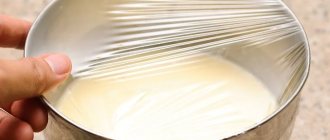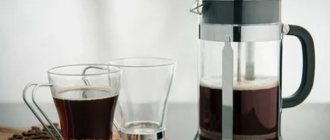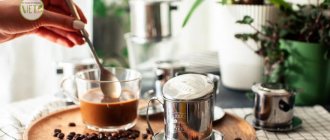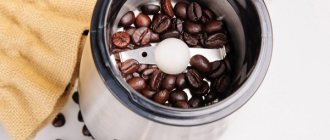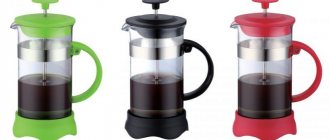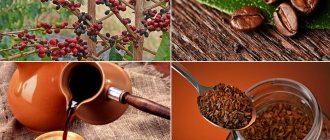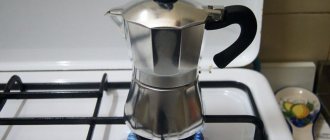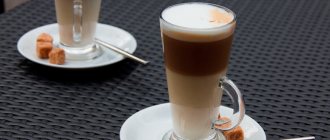A French press is a coffee or tea brewer that uses the principle of mechanical pressure to force down and retain the grounds using a filter. This device is often used by coffee lovers. The process of making the perfect drink is an art. It all depends on the craftsmanship, the degree of grinding of the coffee beans and even the sophistication of the coffee cup. Of course, the brewing method stands out among all these factors. And for some connoisseurs, nothing beats making coffee with a traditional French press.
History of the teapot
The technology can hardly be called new: the first French presses appeared back in the 1800s (and yes, in France), although they were far from modern models. At the beginning of the 20th century, the design was noticeably improved in Italy, and by the mid-50s, the French press acquired its modern look, and this was done, again, by the French.
In the post-Soviet space, French presses gained mass popularity already in the 2000s, when they began to be found in literally every tea and coffee store, as well as in kitchenware departments. But at first they were used exclusively for making tea, and coffee was prepared in other ways. And, perhaps, only in the last decade have French presses been used for coffee
Design features of French presses
All teapots are of the same design and consist of five main elements:
- The flask is where the brewing takes place. The most commonly used glass flask is made of heat-resistant borosilicate glass. This is exactly what is used, only thinner, for glass baking dishes. Even a sharp change in temperature or strong sudden heating does not lead to the appearance of cracks. But the flask is not shockproof - if you drop it, or hit the coffee pot too hard, the flask will break. There are also metal flasks, which are much stronger and last, in general, forever, but you need to specifically look for this; there are few offers in stores. There is also ceramics - it is believed that the drink tastes better in it, but again, it is very rare.
- The filter is usually three-layer. At the bottom is a frame, then a metal or nylon fine mesh, and then a metal plate with holes, and usually a twisted catcher along the edge.
- A plunger, also known as a piston, connects the lid and the filter.
- Lid. Just a lid, flat or convex, made of different materials. Most often it is stainless steel, but there is also plastic and glass.
- Body and handle. Usually there is either a bottom or legs that protect the surface from touching the hot flask, and the decor both holds the flask and somewhat protects it from impacts.
Most often on the market you will find glass flasks in a stainless steel body, with a metal handle and lid. As a cheaper option - with plastic components.
Operating principle
Preparatory stage:
To brew coffee in a French press, it is better to use coarsely ground coffee up to 0.8 mm (see types of coffee grinds), and to give coffee an even greater aroma, grind the coffee beans immediately before preparing the drink (see is it possible to grind coffee in blender?). Before you start making coffee, to enhance its flavor, you can first rinse the flask with boiling water and wipe dry.
Using a French press is very easy:
- Boil water, let it cool for a minute.
- Pour coffee into a flask and fill it with a third of water - a lot of foam will appear, the coffee will swell and “bloom”.
- You can stir it and then add the remaining water.
- Raise the plunger so that the filter does not touch the top edge of the drink and close the lid.
- Wait 3-4 minutes.
- Slowly lower the piston so that the filter presses down the grounds.
- Pour French press coffee into a cup (see espresso cups).
There is no need to lower the layer of coffee deep, or move the plunger back and forth during brewing. Let the coffee interact with the air, so it will better reveal its aroma.
A hot cup helps bring out the best flavor of this drink. Try heating the cup before pouring the finished coffee, and you will immediately understand its benefits.
Secrets, life hacks and useful tips
Brewing coffee in a French press is a fun process. You can add cardamom, nutmeg, vanilla or cinnamon to the device's container. Every time a completely new drink will appear on your table.
- If you drink coffee and tea with equal pleasure, have two French presses at home. One will be used for brewing coffee, and the other for making tea. This way, the smells of the drinks will not mix.
- Brew coffee for one time only, do not leave it in the French press. Otherwise, the drink will acquire an unpleasant aftertaste.
- Using the device, try making cappuccino foam. Warm the milk to 70 °C and pour it into a clean teapot flask. By raising and lowering the plunger, create a thick foam.
- Try changing the proportions of water and coffee a little. So, you can find your ideal recipe for making a drink. Try not to squeeze out all the liquid, otherwise bitterness from the sediment will get into the drink.
- Rinse the filter thoroughly. Particles of coffee and tea leaves accumulate under the grate.
A French press allows you to do without using a Turkish coffee pot or an expensive coffee maker. The drink prepared from ground grains is infused and acquires an amazing taste and aroma.
How to choose the right French press
- Flask material. It can be plastic (in cheaper models), metal or glass (in more expensive ones). It is better to opt for glass, as it is a neutral material that does not affect taste and smell. When choosing a coffee pot, you need to make sure that there are no cracks or chips on the flask.
- Filter material. If you brew finely ground coffee, consider a synthetic mesh. If the grind is coarse, then a metal mesh will suit you. Moreover, metal lasts much longer. Also, with coarse grinding, it will be easy for you to compress the grounds, but with fine or medium grinding you will have to apply a little force to lower the piston.
- The tightness of the strainer to the walls. The piston in a French press should fit snugly against the walls; it is better to opt for a simple French press with a stainless steel piston. Because the piston, sealed along the edge with a silicone ring, not only has a short service life, but also produces an odor during brewing.
- The handle of the French press and its body are better than plastic, since they will not heat up. — Everyone chooses the volume and external design depending on their taste preferences and needs. This does not affect the taste in any way.
What determines the taste of coffee prepared in a French press?
The taste of the drink is influenced by the freshness of the beans, the degree of roasting, the quality of the water , and, of course, the type of coffee . We talked on the website about how to choose coffee. Now you know how to do it right.
In some articles that tell you how to use a French press at home, you will find advice that for this device you need to use only coarsely ground coffee. Actually this is not true.
If you have a nylon strainer with small holes, then you can choose coffee of any grind. The only thing you have to consider is that it will take some effort to push the plunger down when making finely ground coffee.
The taste of French coffee depends more on the freshness of the ground beans. As we said earlier, the best option is to prepare the grains just before cooking. It is then that the taste of coffee will be fully revealed. You will not make real coffee from ready-made ground beans purchased in packaged packs, even if you know how to use and how much coffee to pour into a French press.
The freshness of the roast also plays an important role. It is advisable that you use freshly roasted coffee - 2 - 4 weeks from the date of roasting .
Even those who know how to use a French press to make coffee will not make good real French coffee from weathered beans.
the quality of water largely determines the taste of coffee. It cannot be boiled again. And, of course, it is better to take filtered, but not distilled. Don't forget about the temperature: for French coffee it is 90–95 degrees (10 seconds of cooling after boiling).
What type of coffee is better to choose?
A French press is convenient because you can make any type of coffee in it. But the best ones will be the expensive single-origin varieties, such as Kopi Luwak, Jamaica Blue Mountain, and Green Bourbon “St. Helena.”
Today, if you try hard, you can find coffee blends specifically designed for the French press.
The device is also convenient because you can immediately pour spices if you like to add them to your drink. Please keep in mind that coffee is prepared very quickly using this method, and not all spices will be able to manifest themselves in such a short time. You can brew the spices in advance and pour the resulting decoction into coffee - use it instead of water.
Advantages and disadvantages
When people talk about what a French press is, they usually explain how to use it, but few people reveal all the benefits of this teapot.
So, here are the reasons to start using a French press.
Advantages
- Delicious and aromatic coffee;
- The grounds are filtered out efficiently, but it is precisely this that often causes irritation of the stomach and intestines. And it’s simply more pleasant to drink coffee when the particles don’t stay on your teeth.
- You can brew your favorite coffee wherever there is boiling water. You don’t need a stove or a Turk (see recipe for oriental coffee). And even the water will not be too hot, the drink will be brewed, but there will be no grain particles in it (and this often happens when you brew coffee in a mug).
- Your coffee is guaranteed not to burn or run away. Very convenient for those who are distracted from the Turk for a second and then have to wash the stove.
- Even a child can handle preparing the drink. It’s difficult for him to keep track of the Turk, and the stove needs to be turned on, but for a French press you just need to press the button on the electric kettle, boil water, pour it into the flask and cover with a lid.
- Unlike coffee machines, due to the long brewing time, the French press allows the maximum amount of oils, flavors and aromatic compounds to pass into the water (see the chemical composition of coffee). You will be surprised how rich and deep the taste of your favorite drink will be.
- You can adjust the strength of the coffee (depending on the infusion time);
- Low price;
- Easy to care for;
- The ability to add spices immediately while preparing the drink;
- Does not consume electricity;
- Compactness;
- Multifunctional (suitable for making tea, tea drinks, etc.).
Flaws
- Manual method of preparing the drink;
- You must additionally have a kettle or other device for heating water;
- You cannot store the drink in it for a long time to avoid oxidation and damage to the parts of the French press.
Caution: If you are used to espresso from a coffee machine (see espresso recipe), the drink from a French press may be too strong for you.
Important nuances and tips for selection and use
Now you understand what a French press is, and perhaps you want to buy one, or try making coffee in the one you already have.
Here are some tips from the professionals:
- Use coarsely ground coffee. It’s best to either buy grains and ask them to grind them in the store: tell them what you need coarsely, for a French press, or grind them yourself. Pre-ground coffee "espresso blend" or "brew in a cup" will not work as the particles are too fine and will end up in the cup.
- Always brew enough coffee in a French press to pour into cups to drink immediately (see how to properly store coffee). If coffee sits too long in the brewer, it will become bitter and acquire a chalky taste. You can measure the water with a cup so as not to make a mistake with the volume (see the volume of a coffee cup).
- Do not squeeze out the liquid to a drop. This will squeeze out the bitterness from the grounds and the drink will acquire an unpleasant aftertaste. Just carefully lower the plunger to the bottom and pour.
- French presses made of stainless steel are a purchase for at least decades. But they usually do not show how the brewing process is going. In this regard, glass ones are more convenient, but they are less durable.
- Many manufacturers have replaceable glass bulbs and pistons, but this needs to be clarified when purchasing. Some even include an extra flask in the kit. You can also often find 7 gram measuring spoons - that’s how much coffee you need for one serving.
In most cases, you can wash your French press in the dishwasher. This is a device where nothing gets damaged by hot water or detergent.
As a last resort, remove the flask from the plastic case and wash only it. There is no need to use abrasive products, and in principle, everything is easy to clean even with a regular sponge and dishwashing detergent.
To brew tea and coffee, it is better to use different French presses. Otherwise, an unpleasant aftertaste from another drink may appear.
Design Features
Coffee and tea lovers appreciate the quality of drinks brewed in a French press and are replacing the usual Turks and teapots with a press design. It is convenient to make coffee in such utensils at home; they are simply irreplaceable in office kitchens. A device, regardless of its quality and cost, consists of several required parts:
- Flask. Made from heat-resistant thin glass, ceramics, metal or plastic.
- Metal piston. It can be equipped with plastic elements.
- Filter. Selected depending on grinding. If fine grinding of coffee is preferred, you need a nylon element that can retain the smallest particles. For lovers of coarsely ground coffee and loose leaf tea, a metal mesh with larger cells will be enough.
- Frame. Made from plastic or metal. Its purpose is to protect the owner of the structure from burns, and the flask from damage.
You need to choose a device carefully, especially if you plan to use it for a long time and often. In order not to be disappointed in French presses for coffee and tea, you should understand how to use the device and try to brew each drink correctly. People who cannot imagine the morning without a cup of coffee, and who prefer tea during the day, should think about purchasing a French press coffee pot and a similar device for brewing tea.
Flask
It is the main part of the French press. It is believed that the best flasks are made of ceramics, metal ones are attractive due to their durability, glass ones allow you to observe how the brewing takes place. The element has the shape of a cylinder with a small spout. The volume can range from 350 ml to 1.5 liters.
- The glass coffee press remains the most popular. For production, thin borosilicate glass is used, resistant to high temperatures. This flask is easy to clean and the device looks stylish in any kitchen. The disadvantage of the glass element is its fragility. The part breaks easily when dropped, and can crack if the French press coffee maker is not carefully placed on the table. Possible chips and scratches with intensive use.
- French presses with double walls are very beautiful and functional. Such models, which are especially popular, are called French coffee pot. The inner and outer layers of the device are made of stainless steel. The design is very reliable and durable, combining the advantages of a convenient coffee pot and thermos. Coffee and other drinks in a French press are well infused and cool slowly. The disadvantage is that if the quality of the dishes is of questionable quality, the coffee or tea may develop a metallic taste. Sometimes the outer wall gets slightly warm. Such models are more expensive than glass structures of similar volume.
- French presses with a ceramic flask are produced quite rarely. They are very beautiful because the outside is covered with paintings. The flask is easy to clean, does not absorb odors, and is much stronger than glass. The only drawback is that such a device cannot be called a budget option, but coffee prepared in a ceramic French press has a particularly rich aroma.
- Not long ago, designs with plastic flasks appeared on sale. If such a coffee press is produced by a well-known brand, you can purchase it without fear. Manufacturers care about their reputation and use high-quality plastic. Such elements are stronger than glass ones and heat up less during the preparation of drinks. Disadvantage: the bulb is easily scratched and difficult to clean.
Any model of device can be washed in the dishwasher.
Double
Ceramic
Metal
Glass
Piston and filter
Filters for French presses can be metal; they are used for brewing large-leaf tea and coarsely ground coffee. For people who prefer fine grinding and fine-leaf tea, it is better to use nylon analogues. Both can be easily removed and washed in the dishwasher. In a high-quality French press coffee pot, several (up to 4 pieces) filters are installed. This eliminates the possibility of tea leaves particles getting into the drink.
A coffee press is always equipped with a metal piston. There is a handle at its upper end. The plunger is firmly connected to the lid, at the other end it is equipped with a disk that ensures tightness and filters. The spring is responsible for the tightness of pressing against the walls of the flask.
In order for the drinks to be tasty and aromatic, it is necessary to promptly remove the remaining tea leaves from the French press and wash it thoroughly. Do not prepare herbal infusions in a container intended for coffee or tea. When washing a French press coffee pot, you can use dish soap or baking soda, which cleans the surface well of characteristic deposits.
Piston
Filters
conclusions
- A French press is a brewer for coffee or tea in which the grounds fall to the bottom and are retained with a filter (see which has more caffeine - tea or coffee?).
- Most often, French presses are made of glass and stainless steel, but various options are possible.
- Among the main advantages of a French press is ease and safety of use; only boiling water is required to prepare the drink.
- Choose a coarse grind of beans, and always brew as much as you will drink at once, do not keep the coffee in a French press.
- The same French press is suitable for tea and coffee, but it is better to have different ones.
Do you use a French press? Do you have a favorite brand or manufacturer? Share your opinion in the comments!
Step-by-step recipe for brewing coffee
In order for the dosage to be correct and the result to be stable, the coffee must be weighed before preparation. If this is not possible, the base is poured into the French press flask up to the beginning of the handle or to the level of the filter when lowered. And you need to understand that there is no such thing as the “right drink” - the ideal one is born as a result of experiments.
Interesting! How to make a latte in a coffee machine
Let's look at how to prepare coffee step by step (since a French press is often used as a tea infuser, the recipe for making it will be similar):
- Heat the water to the desired temperature.
- Pour the crushed grains into a heated device (you can immediately add spices to taste, but just a little - literally at the tip of a knife).
- Fill the base with a small amount of water, but so that the coffee is completely covered.
- We wait half a minute - this is necessary for the taste of the grains to develop. Visually, the coffee mass will swell and its volume will increase.
- Pour in the remaining water, close the device and leave it for about 5 minutes.
- Use a spoon to skim off the foam that has formed on top.
- After this, press the piston. If its movement is too tight, you need to repeat the pressure several times.
- Press the grounds to the bottom, filtering the drink.
Coffee (or tea) is ready.
How to brew a cold brew
In this way, you can not only brew hot coffee, but also make cold coffee, which even has its own name - Cold Brew. Its preparation differs in that instead of boiling water, cold water is poured into the French press flask. After this, the drink is left at room temperature or put in the cold for 9-12 hours. In this case, the vessel does not need to be closed. During this time, the drink will reach the desired aroma and consistency, and will be saturated with oils and beneficial substances. The required time must be maintained; if you take it out earlier, you will get “coffee water” and not Cold Brew.
After the specified time has passed, the piston must be lowered a few centimeters (this is not required until the end, since bitterness may appear). To pour into a mug or glass, use a filter, which can be replaced by gauze folded several times or a fine sieve. If the drink is not filtered, it will turn out to be too tart and concentrated. Before using it, you need to add a couple of ice cubes.
What kind of coffee do you like best?
ColdHot
Properly brewed Cold Brew has a full-bodied flavor with a natural coffee aroma and moderate sweetness.
Interesting! Methods for brewing coffee in a Turk on the stove, the best recipes and basic rules
